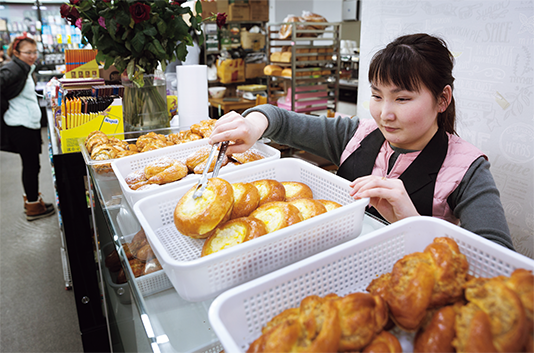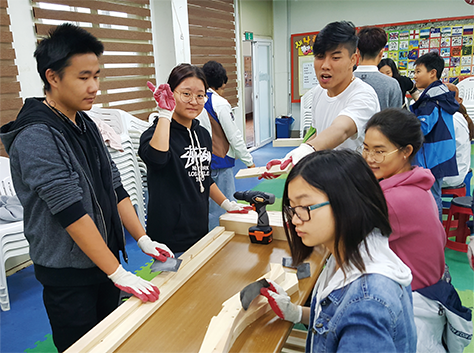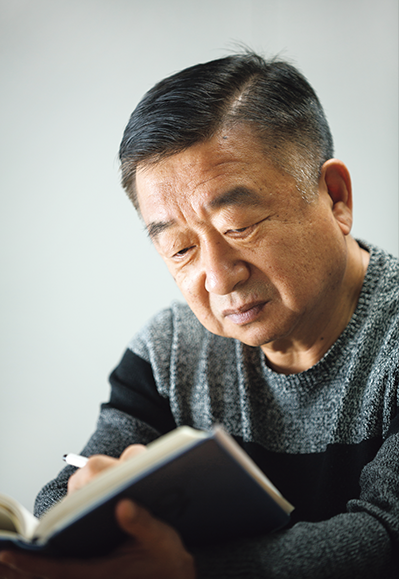Many signs of the backstreet stores are written in the Cyrillic alphabet and passers-by are more likely speaking Russian than Korean. That is typical here in the Wolgok-dong neighborhood of Gwangju’s Gwangsan District, where a community of Goryeo-in, or ethnic Koreans from Central Asia, has developed. Goryeo-in, or Goryeo-saram as they call themselves, means “Goryeo people,” descendants of Koreans who migrated to Russia in the late 19th century to the early 20th century. The word Goryeo comes from the ancient Korean kingdom of Goryeo, which ruled the Korean peninsula from 918 to 1392.
Children learn Hangeul, the Korean alphabet, at a daycare center in Goryeo-in Village in Gwangju. Ethnic Koreans from Central Asia are extremely focused on their children’s education, especially Korean language proficiency. The village also operates various levels of Korean language courses for adolescents and adults.
Ethnic Koreans living in the Commonwealth of Independent States are commonly called “Goryeo-in.” They are descendants of Koreans who migrated to Russia over 100 years ago. Their grandparents and parents experienced at least three diaspora over three to five generations. The first major waves of Koreans migrated to Primorsky Krai, or Maritime Province, in the Russian Far East during the Japanese colonial rule of Korea in the early 20th century.
In 1937, however, the Stalin government deemed immigrants and ethnic groups inherently disloyal to the Soviet state and deported them to barren areas of Central Asia. Included among these groups were ethnic Koreans, who at the time were subjects of the Empire of Japan, which was hostile to the Soviet Union. In just over two months, a total of 171,781 ethnic Koreans (36,442 families) were forcibly relocated to Kazakhstan and Uzbekistan. Upon arrival, they were faced with harsh living conditions which led to tens of thousands of deaths from disease and malnutrition.

Café Семья [Family] sells oven-fresh Central Asian bread baked in the traditional way. Goryeo-in can enjoy their hometown food, while visitors from other areas can try unfamiliar food.
Building Their Own Village
After the Soviet Union dissolved in 1991, their descendants continued to suffer discrimination in the now independent Central Asian countries, which prompted many of them to move to the land of their ancestors. As many as 40,000 ethnic Koreans from Central Asia currently live in Korea, and about one-tenth of them reside in Gwangju’s Wolgok-dong neighborhood. Most of them found work in an industrial complex in the city or a nearby agro-industrial park, so they naturally looked for cheap studio apartments near their workplaces. Hence, part of Wolgok-dong has turned into their enclave.
Despite their unfamiliar environment and difficult economic conditions, the Goryeo-in are creating their new nest with a strong community spirit. They are rebuilding their lives strenuously, after independently establishing support facilities, including a cooperative association, community shelter, local radio stations and centers for daycare as well as for children and community activities.
Amid the growing influx, an increasing number of the new settlers have become successful small business owners. A café named “Cемья,” Russian for “family,” sells leavened flatbread and grilled meat on skewers, both staple foods of Central Asia. It is considered the first gourmet destination in this community. Jun Valery started it in 2015 and the cafй now has four branches, including those managed by his eldest daughter and son and their spouses. “Koreana,” a European-style cafй opened by Huh Anastasia in October 2017, is also gaining popularity. These types of success stories have multiplied, giving rise to a business district of their own clustered with restaurants, travel agencies, currency vendors and souvenir shops, among other stores.
Ethnic Koreans from Central Asia began to settle in Korea around 2001 when Shin Joya arrived.

Saenal [New Day] School, the first alternative multicultural school in the country, offers a variety of job training programs, including a carpentry class, for ethnic Korean adolescents from Central Asia so that they can assimilate into Korean society smoothly.
A third-generation Goryeo-in, Shin asked Lee Chun-young, the pastor of the Saenal (“New Day”) Church in Gwangju, for help when she could not receive her back pay from a factory where she had worked. In 2005, Shin founded Goryeo-in Village with Reverend Lee’s help and opened a community center in an old shopping mall. After 2007, when the government began issuing visitor work visas for ethnic Koreans from China and Central Asia, the number of Goryeo-in arriving in Gwangju rose sharply.
The reason they are rushing to Gwangju is simple. News spread far and wide by word of mouth throughout Central Asia that the community center helps new arrivals find room and board and provides translation services. This was made possible thanks to Shin’s attitude to help newcomers resolve their problems as if they were her own relatives and friends. The transplants from Central Asia often say, “We could hardly survive were it not for Joya.” Shin has more than 2,000 phone numbers of her fellow resettlers stored in her cellphone. Her husband, a defector from North Korea whom she married in 2008, is also a strong supporter of the community.
“No matter how highly educated they are, ethnic Koreans are treated with low regard in Uzbekistan.
In most cases, they can’t find jobs even if they have more than two college degrees,” Shin said. She decided to leave for her grandparents’ land, because it was too hard to scrape out a living.
Jung Svetlana, another third-generation descendant, migrated here for the same reason. “After I arrived, I began working at a washing machine assembly line,” she said. “As a side job, I washed dishes at a restaurant on Sundays. That way, I saved 500,000 won to pay the deposit for a one-bedroom studio apartment.”
Education of Future Generations
Ethnic Koreans, who could speak only Russian, were gradually reduced to an underprivileged class, as Central Asian nations, which gained independence after the collapse of the Soviet Union, passed new language laws and constitutions that favored the dominant national or ethnic groups. Ironically, here in Korea, it is once again their language ability that remains the biggest barrier facing the very people who left their hometowns because of language discrimination. From filling in visa application forms to sending children to school or simply going shopping, routine tasks can present stumbling blocks if they have inadequate Korean language skills.
The linguistic difficulties make the residents of this village consider it their most important task to educate future generations. Most ethnic Koreans from China or migrant workers from Southeast Asia come here alone and mainly focus on earning money. But most Goryeo-in arrive as three-generation families and thus pay keen attention to the education of their children.
The institution responsible for educating children in this community is Saenal School, the country’s first multicultural alternative school. It opened in 2007 and was accredited by the Education Ministry in 2011. This tuition-free school is well-known, even among ethnic Koreans in Central Asia, because it provides both primary and secondary education, attaching importance to all-round personality development. The school is run by Reverend Lee, who was instrumental in developing the community alongside Shin Joya. In a sense, Shin and Lee are the “godmother” and “godfather” of the village.
Several village institutions offer Korean language classes at different levels and different hours. With enrollment rising, there are currently three levels of classes for adults - beginner, intermediate and advanced - and special classes for children who have recently arrived. Language programs on Goryeo FM Radio are highly popular with those who miss classes because of their work schedule.
The community’s children center that opened in 2013 teaches primary and secondary students Korean, English, Russian, math and art, as well as playing soccer and guitar, after school. The daycare center that opened in 2012 helps young children from dual-income families with Korean reading and writing and physical education from morning till evening, providing them with meals and snacks. Since July 2017, the village also has been offering Russian classes for primary schoolchildren on weekends, because most parents here want their children to learn both Korean and Russian.
“We’ll prove here in our homeland that we’re proud descendants of the Korean nation by upholding the wishes of our ancestors who dedicated themselves to seeing their country’s sovereignty restored.”
Goryeo-in Village celebrates the third Sunday in October as “Day of Goryeo-in.” Children of the village pose after performing a traditional Korean fan dance on the fifth annual “Day of Goryeo-in” in 2017.
Community Networks and Media
The community support center is the heart of the village. It serves as a temporary shelter for those who have no other place to stay and have to find a job, and as a counseling center that helps resolve all kinds of problems, including finding a job, dealing with work-related accidents, retrieving back pay and assisting with visa problems.
Another important facility is the community history museum that opened in June 2017, adjacent to the community support center. Inside the small museum, visitors can learn about the fight against Japanese imperialism and support for Korea’s independence movement by Koreans who had settled down in the Russian Maritime Province starting from the 1860s. The museum also recalls the ubiquity of the discrimination and unfair treatments that their descendants endured. In 2017, the village organized an event to commemorate the 80th anniversary of ethnic Koreans’ deportation to Central Asia.
The community’s media form one of the pillars of the village. Its residents operate a help network through the local radio stations, Goryeo FM and Nanum (“Sharing”). They offer support to anyone facing difficulties, such as suffering from a serious illness or having trouble paying medical expenses. Goryeo FM is the first-ever radio station run by ethnic Koreans who have found a new home in the country of their ancestors. Eighty percent of its programs are in Russian for the convenience of community members who are more comfortable listening to Russian than Korean. This 24/7 radio station is so popular that even their relatives and friends in Central Asia listen to its programs with a smartphone app. Meanwhile, Nanum Radio supplies detailed news about the village to some 110,000 listeners every day via Facebook and email.
Fourth-Generation Descendants
The community spirit of the Goryeo-in in the Gwangju area is strong. Residents help each other organize weddings and funerals and gather volunteers who clean the streets and help prevent crimes. They also established a monthly “Visit Goryeo-in Village Day” to attract attention from the general public, and in November 2017, the village welcomed Uzbekistan’s Minister of Preschool Education Agrippina Shin.
There are a variety of support programs underway for the village residents. Nevertheless, life here is not always easy. Residents feel particularly helpless when they fall ill. Even if they become eligible for health insurance coverage after staying 90 days, it is still a considerable burden for most of them to pay 100,000 won for their health insurance every month.
Another chronic difficulty is obtaining visas. The current law regards only first- through third-generation Goryeo-in as “overseas ethnic Koreans” and grants them long-term stay permits, but classifies fourth and younger generations as “foreigners.” Accordingly, the latter must leave Korea when they turn 19, even if they were born in Korea, or have to leave and re-enter the country repeatedly to renew their three-month visitor visas. There are currently some 400 fourth-generation descendants in the village who are inconvenienced by these visa constraints.
This year marks the 30th anniversary of the first arrival of Goryeo-in. “We’ll prove here in our homeland that we’re proud descendants of the Korean nation by upholding the wishes of our ancestors who dedicated themselves to seeing their country’s sovereignty restored,” said Shin Joya.
‘A Twist in Life’
The Story of Kim Vladimir
Kim Vladimir, a poet and third-generation ethnic Korean from Uzbekistan, stands out among residents of Goryeo-in Village. It is not because he was once a university professor who is now working as a day laborer, but because he is such a spirited supporter of other resettlers in the village. He is the Russian-language host of “Happy Literature” on local radio station Goryeo FM. He often attends national or municipal events as the community’s representative.
“I’d held nothing in my hand besides pens,” he said. “But manual labor is the only thing I can do here because I’m not good at Korean. However, since I underwent small intestine cancer surgery a few years ago, there’s hardly anything I can do that requires physical strength. I now grow and harvest apples, pears, blueberries and strawberries at orchards and farms.”

Kim struggled to adjust to working in a factory for the first time. During his initial three years in Korea, he regretted relocating and seriously considered returning to Uzbekistan. But on the other hand, it was good for him to have come to Korea out of respect for his father’s last wishes. “My father told me about Korea right before he died in 1990. He told me to ‘go back to our homeland under any circumstances,” he recalled.
During his spare time, Kim revels in writing poems. In February 2017, “First Snow in Gwangju,” his first collection of poems written in Korea, was published. The title borrows from one of the 35 poems in the collection, which Kim wrote in Russian. Jeong Mak-lae, a former professor of Russian literature at Keimyung University in Daegu, encouraged Kim to have the poems published. They became acquainted when Jeong was preparing a thesis on ethnic Koreans in Central Asia. She translated the poems and in the book the collection appears in both Russian and Korean.
Kim’s poems vividly convey his love for his ancestors’ homeland and its nature as well as the joys and sorrows of the lives of his grandfather and parents. A verse in one of his many poems stands out and stings us to the quick.
“Republic of Korea! O our homeland, please understand / that we lived far away, not because of our fault.” (from “80 Excruciating Years of Wait”)
In the summer of 2017, Kim represented his community in “A Nostalgia Train Ride: Trans-Siberian Silk Road Odyssey,” a 14-day trip jointly sponsored by the Commemorative Committee for the 80th Anniversary of Stalin’s Deportation of Koreans to Central Asia and the Korean Global Foundation. The journey on the Trans-Siberian Railway went from Vladivostok in Russia to Ushtobe and Almaty in Kazakhstan, retracing the arduous steps of the displaced Korean ancestors. Kim plans to devote his second collection of poems to their forcible relocation.
Kim taught Russian literature at the Tashkent State University of Foreign Languages and the Tashkent Medical College in Uzbekistan for about 30 years. But he had to retire at an early age of 55 in accordance with retirement regulations. He then decided to relocate to Korea and boarded a plane bound for his ancestral homeland in March 2011. His wife and children followed soon after. But he still longs for the day when he can say proudly, “This is my homeland.” One of his poems clearly reveals his feelings.
“My friends, in my historic homeland / (…) I don’t want to hear such a pejorative term as foreigner / because I’m a Goryeo-in, I’m a Korean / spiritually, conscientiously, and genealogically.” (from “Chuseok” [Korean Thanksgiving Day])